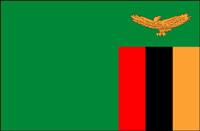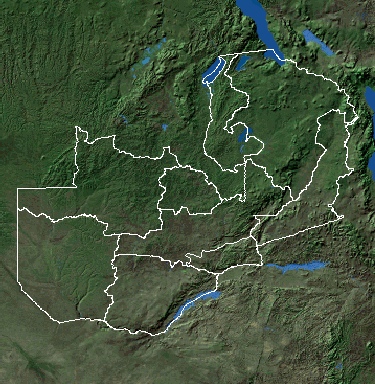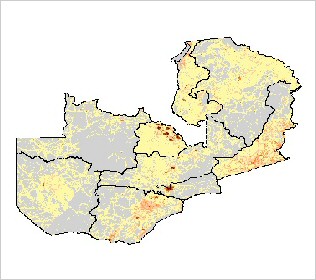|
|  |
| back to top | |
|
Population. The historical and present day distribution of cheetah in Zambia appear to be similar, although the range has contracted. Liuwa Plains National Park, the northern section of the Kafue National Park and South Luangwa National Park still hold populations of cheetahs, although it was not possible to estimate population sizes. Cheetahs are reported from the Chimbwi plains area of the Bangwelu complex of protected areas, but sightings are infrequent. Cheetahs are also reported from the area between North and South Luangwa Parks, but appear to now be absent from the North Luangwa Park. It is not clear if cheetahs are still vagrant or extirpated in the Lower Zambezi National Park and surrounds. No data were available regarding the status of cheetahs in the remaining national parks, and in unprotected areas. The main threat to cheetahs appears to be a loss of suitable habitat and competition with humans and a reduction in available prey. Given the reduction in range, there is an urgent need for a survey of Zambia to determine cheetah population sizes, and threats to their survival (Purchase 2007). | |
| back to top | |
|
The territory of Northern Rhodesia was administered by the [British] South Africa Company from 1891 until it was taken over by the UK in 1923. During the 1920s and 1930s, advances in mining spurred development and immigration. The name was changed to Zambia upon independence in 1964. In the 1980s and 1990s, declining copper prices and a prolonged drought hurt the economy. Elections in 1991 brought an end to one-party rule, but the subsequent vote in 1996 saw blatant harassment of opposition parties. The election in 2001 was marked by administrative problems with three parties filing a legal petition challenging the election of ruling party candidate Levy MWANAWASA. The new president launched an anticorruption task force in 2002, but the government has yet to make a prosecution. The Zambian leader was reelected in 2006 in an election that was deemed free and fair. | |
| back to top | |
|
Area: total: 752,614 sq km; land: 740,724 sq km; water: 11,890 sq km Climate: tropical; modified by altitude; rainy season (October to April) Terrain: mostly high plateau with some hills and mountains Land use: arable land: 6.99%; permanent crops: 0.04%; other: 92.97% (2005) Natural resources: copper, cobalt, zinc, lead, coal, emeralds, gold, silver, uranium, hydropower Natural hazards: tropical storms (November to April) Environment-current issues: air pollution and resulting acid rain in the mineral extraction and refining region; poaching seriously threatens rhinoceros and elephant populations; deforestation; soil erosion; desertification; lack of adequate water treatment presents human health risks Environment-international
agreements: | |
|
|
|
| back to top | |
|
Population: 11,502,010 (July 2006 est.) Age structure: 0-14 years: 46.3% (male 2,673,891/female 2,656,268); 15-64 years: 51.3% (male 2,925,910/female 2,969,324); 65 years and over: 2.4% (male 117,877/female 158,740) (2006 est.) Median age: total: 16.5 years; male: 16.3 years; female: 16.7 years (2006 est.) Population growth rate: 2.11% (2006 est.) | |
|
Infant mortality rate: total: 86.84 deaths/1,000 live births; male: 94.08 deaths/1,000 live births; female: 79.37 deaths/1,000 live births (2006 est.) Life expectancy at birth: total population: 40.03 years; male: 39.76 years; female: 40.31 years (2006 est.) Total fertility rate: 5.39 children born/woman (2006 est.) HIV/AIDS - adult prevalence rate: 16.5% (2003 est.) HIV/AIDS - people living with HIV/AIDS: 920'000 (2003 est.) HIV/AIDS - deaths: 89,000 (2003 est.) Major infectious diseases: food or waterborne diseases: bacterial diarrhea, hepatitis A, and typhoid fever; vectorborne diseases: malaria and plague are high risks in some locations; water contact disease: schistosomiasis (2007) |
|
|
Ethnic groups: African 98.7%, European 1.1%, other 0.2% Religions: Christian 50%-75%, Muslim and Hindu 24%-49%, indigenous beliefs 1% Languages: English (official), major vernaculars-Bemba, Kaonda, Lozi, Lunda, Luvale, Nyanja, Tonga, and about 70 other indigenous languages Literacy: definition: age 15 and over can read and write English; total population: 80.6%; male: 86.8%; female: 74.8% (2003 est.) |
|
| back to top | |
|
Data code: ZA | |
| back to top | |
|
Economy-overview: Despite progress in privatization and budgetary reform, Zambia's economic growth in 2005-06 remained somewhat below the 6%-7% per year needed to reduce poverty significantly. Privatization of government-owned copper mines relieved the government from covering mammoth losses generated by the industry and greatly improved the chances for copper mining to return to profitability and spur economic growth. Copper output has increased steadily since 2004, due to higher copper prices and the opening of new mines. The maize harvest was again good in 2005, helping boost GDP and agricultural exports. Cooperation continues with international bodies on programs to reduce poverty, including a new lending arrangement with the IMF in the second quarter of 2004. A tighter monetary policy will help cut inflation, but Zambia still has a serious problem with high public debt. Labour force: 4.903 million (2006 est.) Labor force-by occupation: agriculture 85%, mining, manufacturing, and construction 6%, transport and services 9% Unemployment: 50% (2000 est.) Population below poverty: 86% (1993) Industries: copper mining and processing, construction, foodstuffs, beverages, chemicals, textiles, fertilizer, horticulture Agriculture-products: corn, sorghum, rice, peanuts, sunflower seed, vegetables, flowers, tobacco, cotton, sugarcane, cassava (tapioca), coffee; cattle, goats, pigs, poultry, milk, eggs, hides Exports: $3.928 billion f.o.b. (2006 est.) Exports-commodities: copper/cobalt 64%, cobalt, electricity; tobacco, flowers, cotton Exports-partners: Switzerland 28.7%, South Africa 18.6%, UK 14.4%, Democratic Republic of the Congo 5.4%, Tanzania 5.1%, Zimbabwe 4.1% (2005) Imports: $3.092 billion f.o.b. (2006 est.) Imports-commodities: machinery, transportation equipment, petroleum products, electricity, fertilizer; foodstuffs, clothing Imports-partners: South Africa 47.6%, UK 12.6%, Zimbabwe 4.3% (2005) Currency: 1 Zambian kwacha (ZK) = 100 ngwee Exchange rates: Zambian kwacha per US dollar - 3,601.5 (2006), 4,463.5 (2005), 4,778.9 (2004), 4,733.3 (2003), 4,398.6 (2002) | |
| back to top | |
|
Telephone system: general assessment: facilities are aging but still among the best in Sub-Saharan Africa; domestic: high-capacity microwave radio relay connects most larger towns and cities; several cellular telephone services in operation; Internet service is widely available; very small aperture terminal (VSAT) networks are operated by private firms; international: country code - 260; satellite earth stations - 2 Intelsat (1 Indian Ocean and 1 Atlantic Ocean) Radio broadcast stations: AM 19, FM 5, shortwave 4 (2001) Television broadcast stations: 9 (2002) Internet country code: .zm Internet hosts: 3,227 (2006) Internet users: 231,000 (2005) | |
| back to top | |
|
Purchase G. 2007. Status and Distribution of Cheetah in Zambia: A Preliminary Assessment. Cat News Special Issue 3, 40-42. http://www.cia.gov/cia/publications/factbook/geos/za.html (last update on 10 January, 2006) http://en.wikipedia.org/wiki/Zambia http://www.lib.utexas.edu/maps/map_sites/country_sites.html#zambia | |



